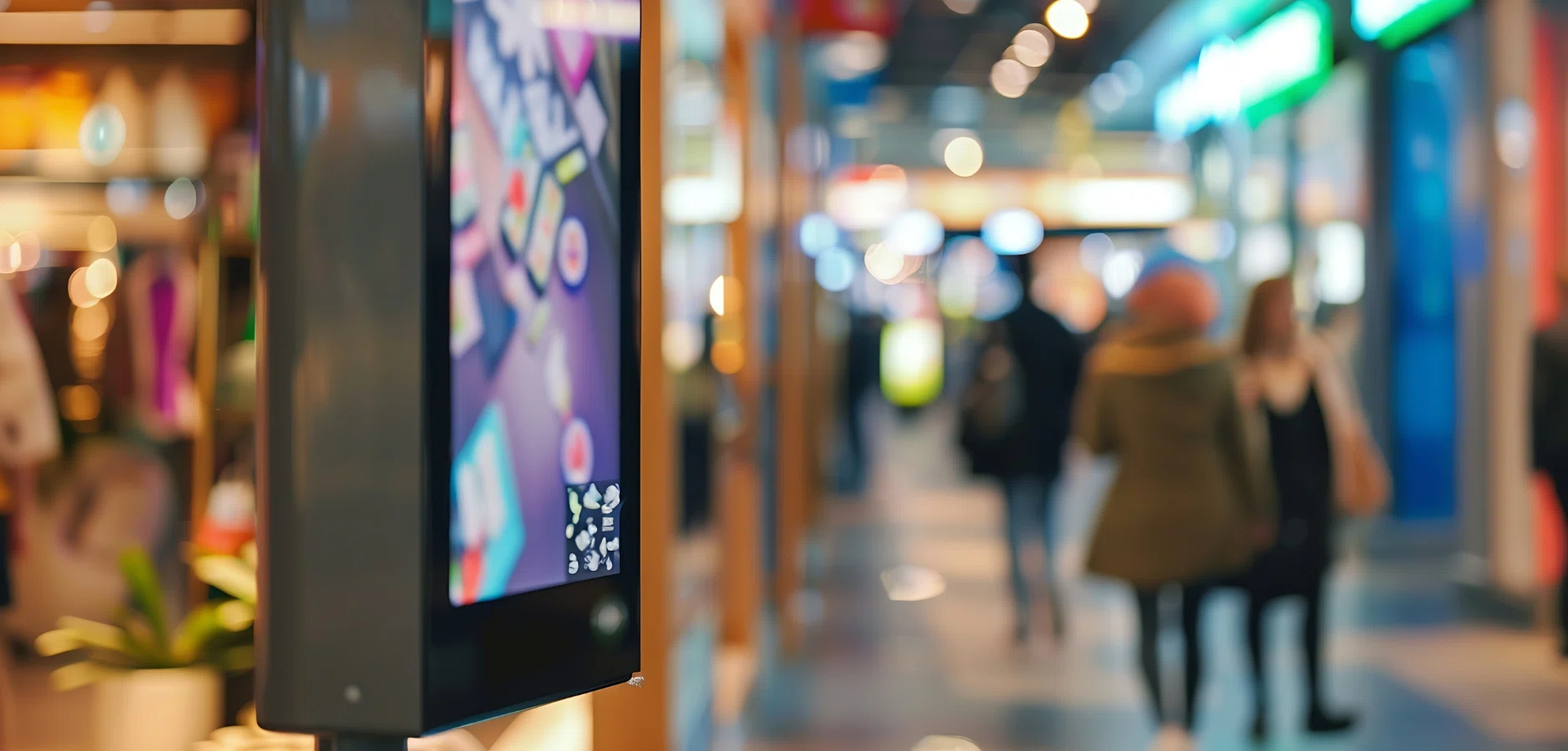With U.S. retail media ad spend projected to hit $97.91 billion by 2028, brand marketers are asking a pivotal question: what makes this channel so impactful?
Retail media marketing refers to advertising opportunities on a retailer’s owned digital properties, such as websites, apps, and in-store digital displays. It has evolved into one of the most effective ways to connect with high-intent buyers, offering a powerful method for driving sales and better ROI.
Marketers must understand the value of utilizing this rapidly growing channel to stay competitive and elevate campaign performance.
This guide explores retail media marketing, its pros and cons, and how to incorporate it into your broader strategy.
Table of contents:
- Why retail media marketing is growing
- How retail media connects with high-intent buyers
- The most common retail media ad types
- The top retail media networks
- Use retail media’s unique strengths to your advantage
Why retail media marketing is growing so quickly
Retail media remains one of the fastest-growing areas of media. Brands are projected to spend over $62 billion on retail media in 2025, a $10 billion increase from last year.
Marketers favor retail media because it reaches shoppers at the critical moment when they’re close to purchasing. This timing boosts conversion rates and provides a direct path to influencing purchasing decisions.
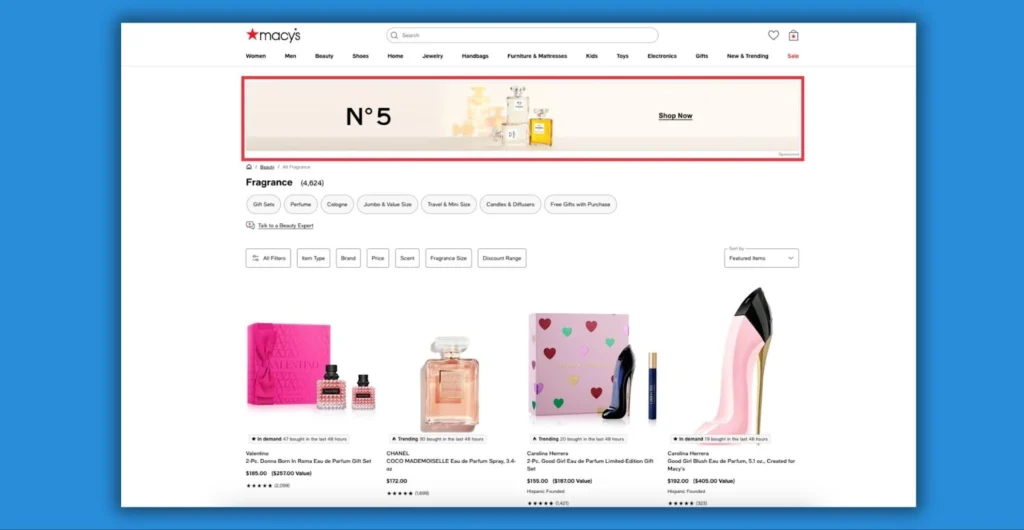
A prime example of retail media: Macy’s features a display ad for Chanel No. 5 at the top of their fragrance product category page.
Several factors are fueling retail media’s growth:
- Shifts in consumer behavior: More people are browsing and purchasing online.
- The decline of third-party cookies: As privacy regulations tighten, advertisers turn to retail media networks that offer first-party data for targeted marketing.
- Demand for personalized marketing: Consumers expect tailored experiences, and retail media enables brands to deliver relevant messaging.
- Proving ROI: Retail media’s closed-loop attribution allows marketers to link ad spending to sales directly.
Retail media networks use rich first-party data from retailers to enable precise targeting. When aligned with a brand’s broader marketing strategy, retail media campaigns deliver a measurable and powerful impact on sales.
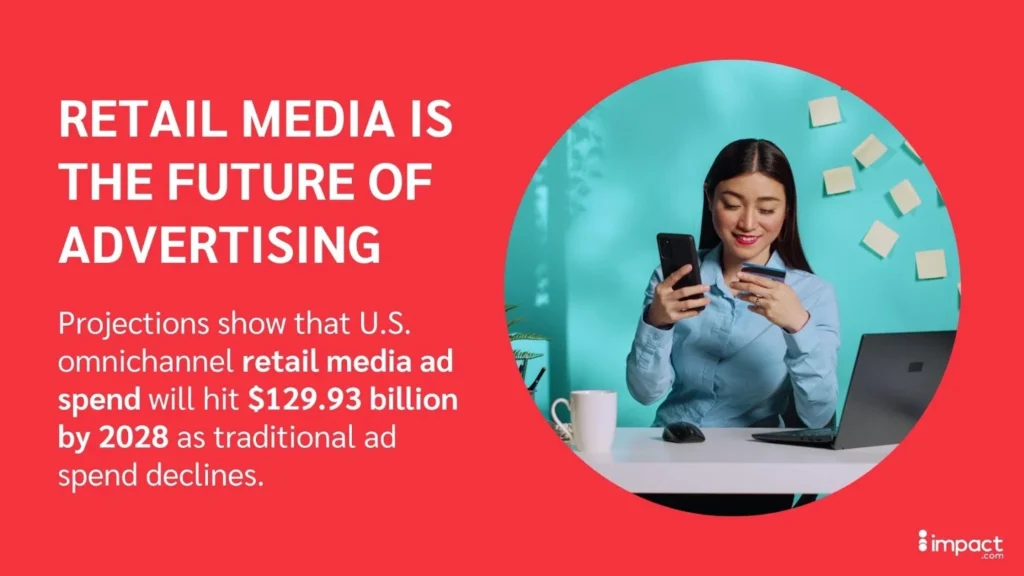
Source: eMarketer
Retail media vs. commerce media
Retail and commerce media aim to connect advertisers with shoppers, but there are key differences. Understanding these distinctions empowers you to choose the right channel for your marketing objectives strategically.
Retail media places ads within a retailer-owned ecosystem, such as Amazon’s platforms or Walmart’s digital properties.
Commerce media is a broader term that includes ads beyond retailer platforms, such as product review sites, travel booking sites, and financial apps.
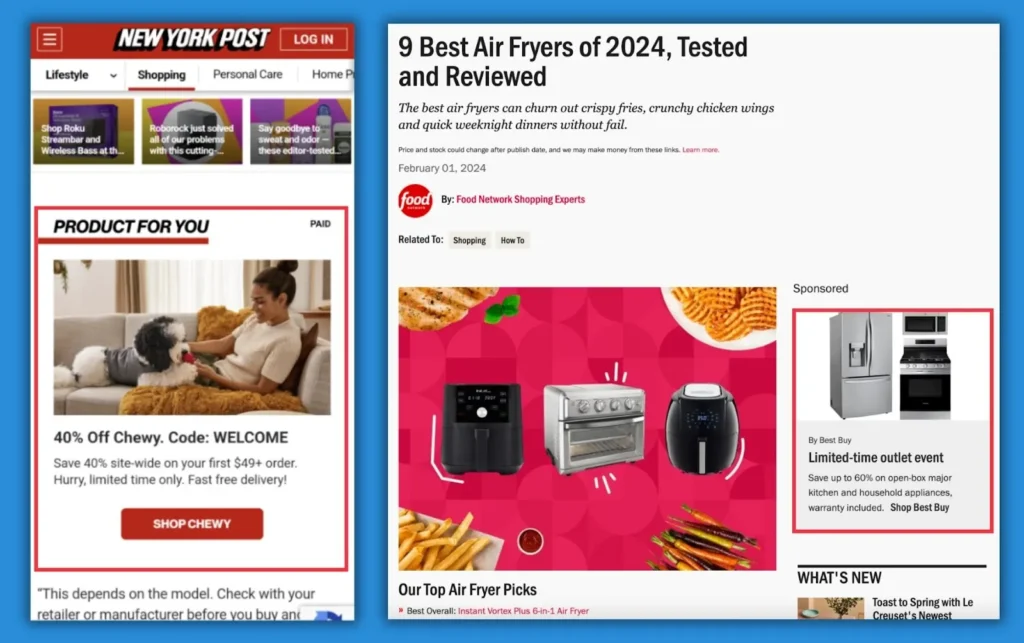
For example, the impact.com commerce media network serves ads that reach consumers at every stage of the buyer’s journey. Its content classification and targeting engine allow brands to place product ads in relevant articles.
Retail media focuses on a smaller, specific audience than commerce media. Retail media targets shoppers actively browsing within a retailer’s platform, usually at the point of purchase. On the other hand, commerce media reaches a broader audience across the entire buying journey, from discovery to consideration.
These media types also use different types of data to function. Retail media relies on first-party data for precise targeting, whereas commerce often uses third-party or aggregated data.
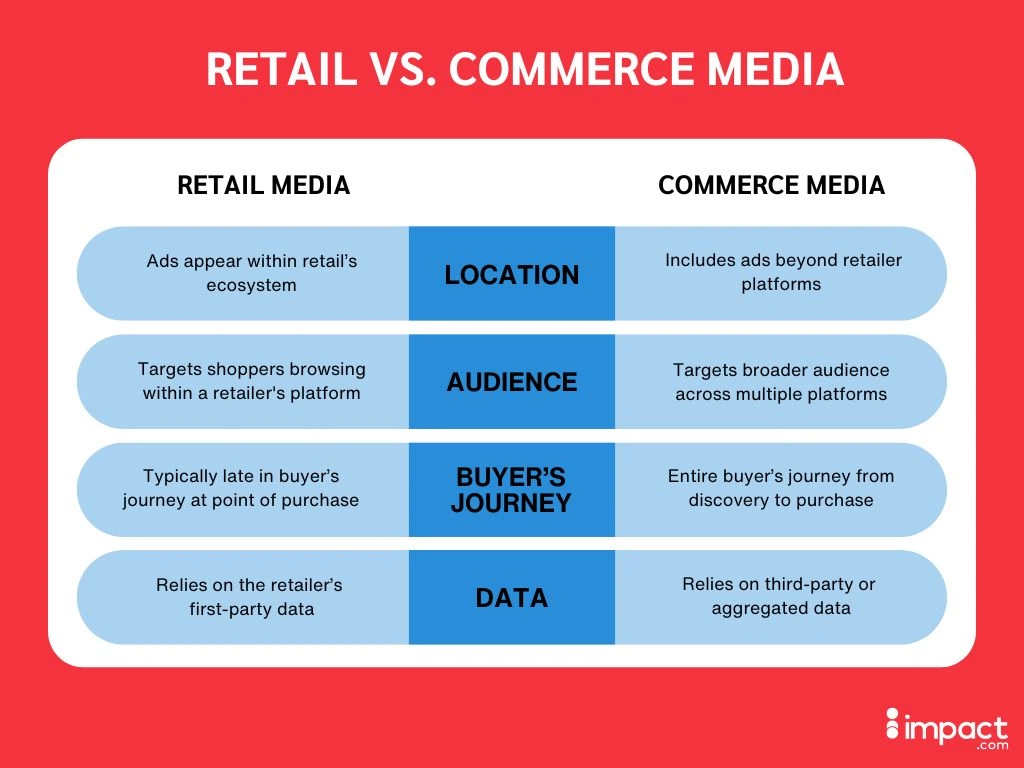
How retail media marketing connects with high-intent buyers
Retail media lets brands connect with in-market shoppers precisely when their purchase intent peaks.
Brands can use first-party data to deliver ads aligned with consumers’ preferences and buying behavior, seamlessly integrating into their purchase journey.
Personalized campaigns fine-tuned to shopper intent have been shown to improve conversions and ROI. To maximize impact, brands often integrate offsite efforts with their onsite campaigns, creating a cohesive, omnichannel buyer experience.
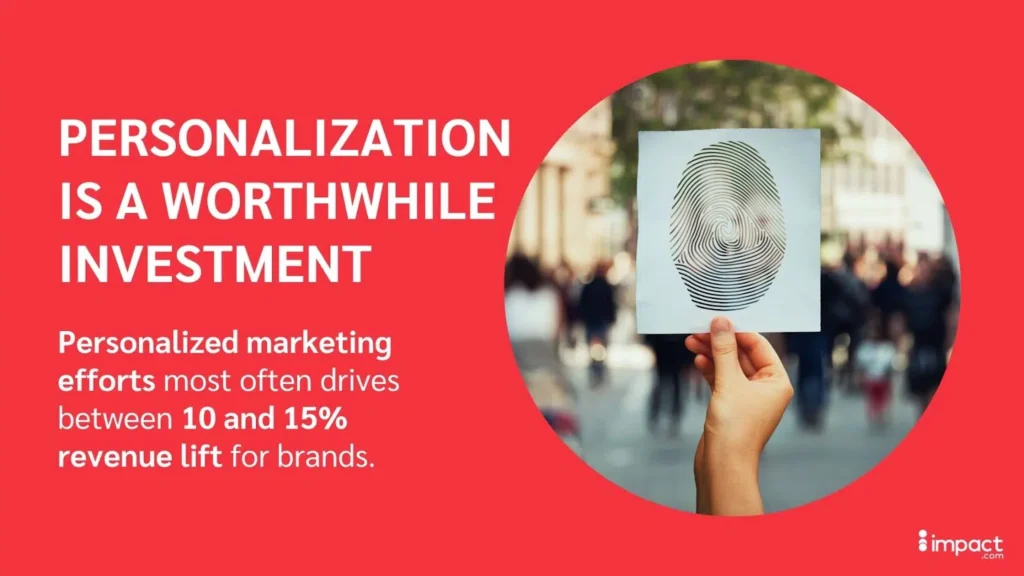
Source: McKinsey & Company
Pros and cons for brands
Like any marketing channel, retail media offers strategic advantages and pitfalls depending on your priorities and goals.
Benefits
- Personalized campaigns. First-party data provides insights into consumer browsing and shopping habits, allowing marketers to create stronger, more relevant campaigns.
- Precise targeting. Connecting with high-intent shoppers at key purchase moments increases conversion rates and sales.
- More efficient. Focusing ad spend on audiences most likely to convert raises ROI.
- Provides measurable outcomes. Marketers gain clear insights into campaign performance and impact.
Drawbacks
- Difficult to measure incrementality. It’s hard to measure the exact impact of retail media ads because they often appear close to the point of purchase.
- Intense competition. Numerous brands vying for ad space on retailer platforms make it harder to stand out and raise ad costs.
- Limited reach. Retail media reaches a smaller pool of people compared to broader digital advertising channels.
- Less control and flexibility. Brands have less say over their ad placements and data usage.
- Complexity. Managing multiple retail media networks can be time-consuming and logistically challenging.
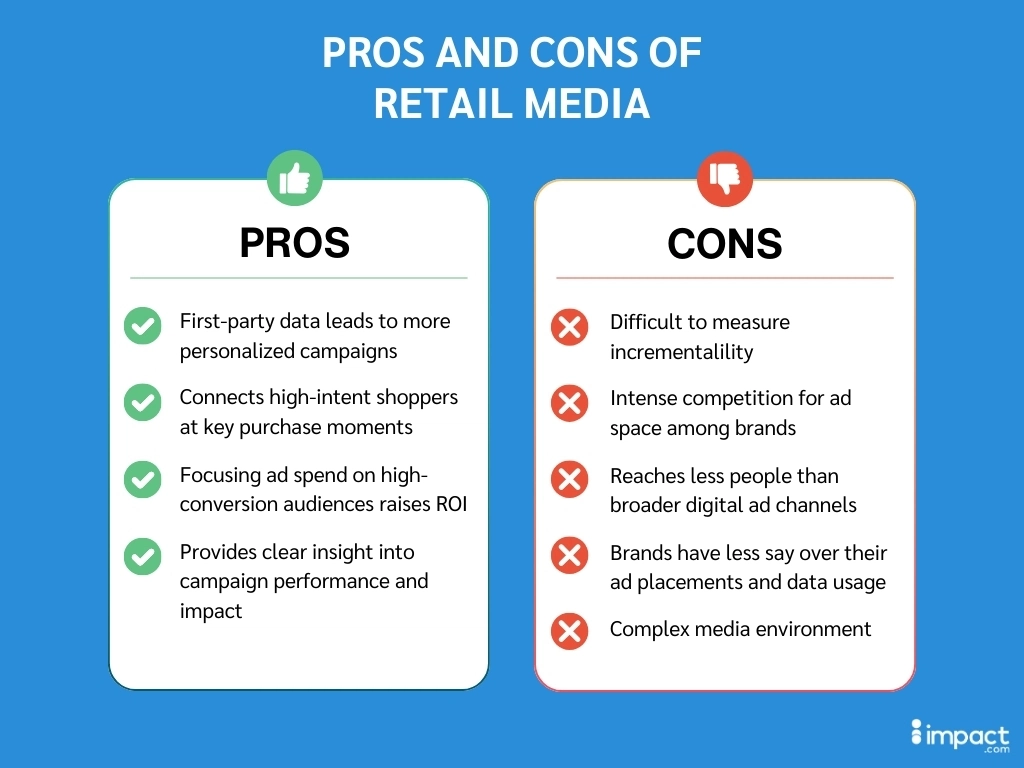
The most common types of retail media ads explained
Retail media shines with its diverse ad formats and placements, allowing you to engage consumers at different points in their purchasing journey.
With a well-structured retail media strategy, you can convert high-intent shoppers poised to complete their purchases.
Popular ad formats
Retail media ads come in different formats, depending on the message you want to share with consumers.
Search ads
Search ads are promoted product listings that appear alongside organic product search results. These ads match the look and feel of the organic product results—similar to paid search ads for major search engines like Google.
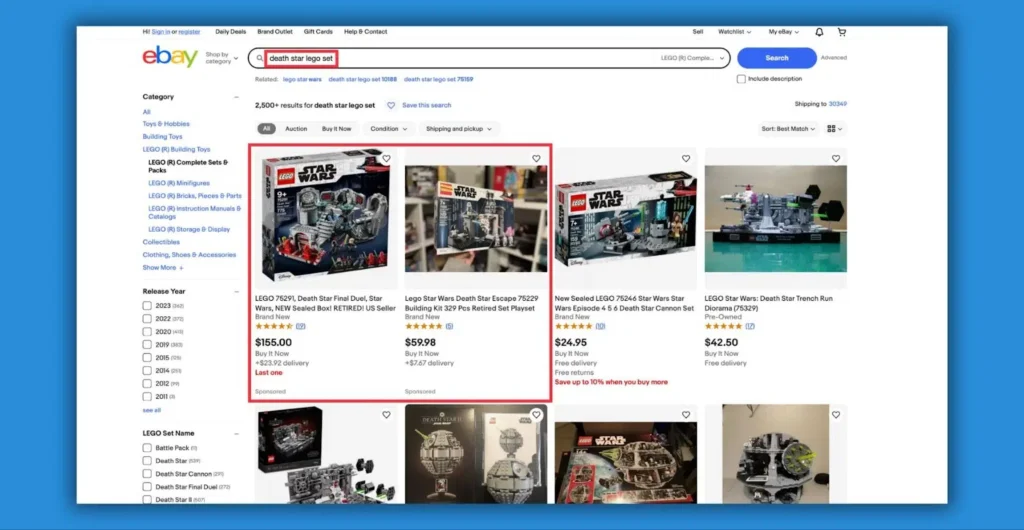
eBay offers search ads that promote product listings for some searches.
Display ads
Display ads are eye-catching banners or graphic ads featured on the retailer’s platform, email, or offsite properties. They’re highly effective for boosting product awareness and recognition.
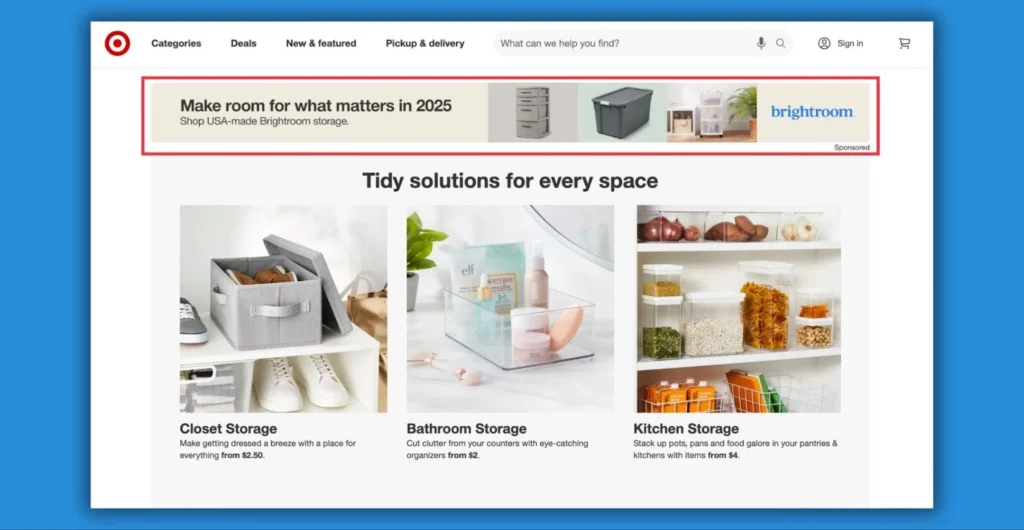
Target features a display ad for Brightroom on its organizational products page.
Sponsored product ads
Sponsored product ads appear alongside product listings on the retailer’s website, helping brands stand out in the search results. This ad type increases product visibility at the point of decision-making.
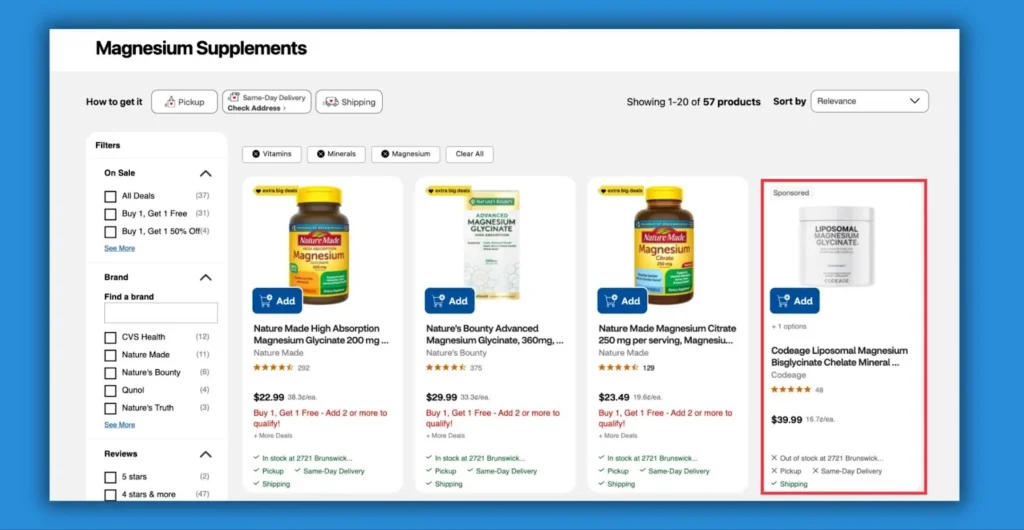
CVS incorporates sponsored product listings seamlessly into relevant product category lists.
Video ads
Video ads convey a brand story or product benefits in an engaging, easy-to-consume way. Many retail media networks also offer the option to make their video ads shoppable, capitalizing on the attention-grabbing format to increase conversions.
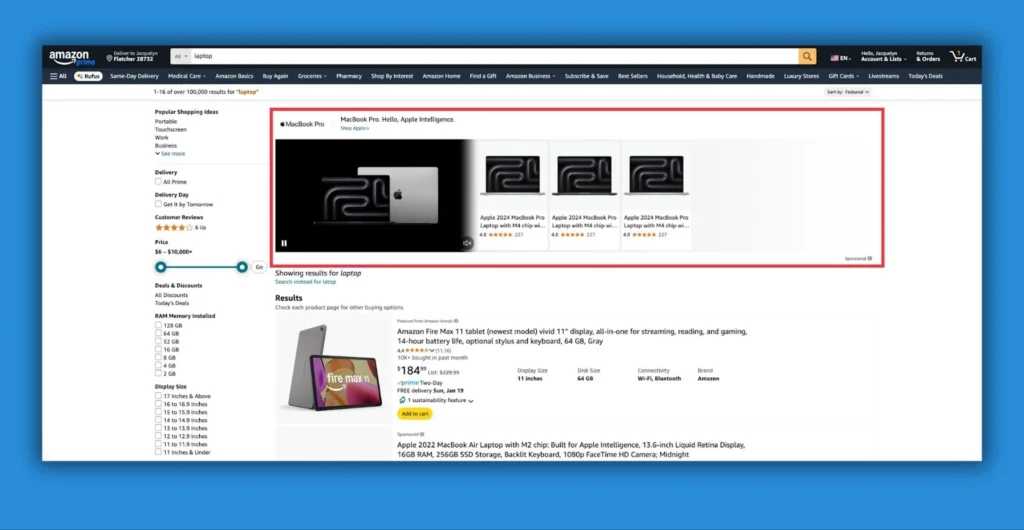
Amazon features a shoppable video ad for Apple’s Macbook Pro on its search results for “laptop.”
Mobile ads
Designed for retailer apps, these ads capture mobile shoppers’ attention.
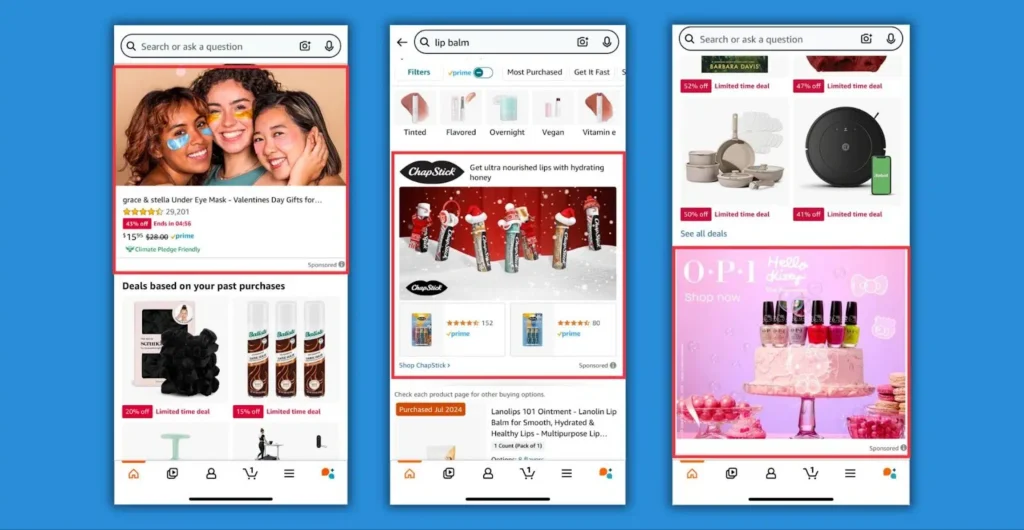
Amazon’s mobile app features ads for various brands on the home page, search pages, and product category pages.
Sponsored storefronts
A sponsored storefront is a custom space on a retailer’s platform where brands showcase their products. It creates a tailored shopping experience, boosts visibility, and encourages more substantial connections with shoppers.
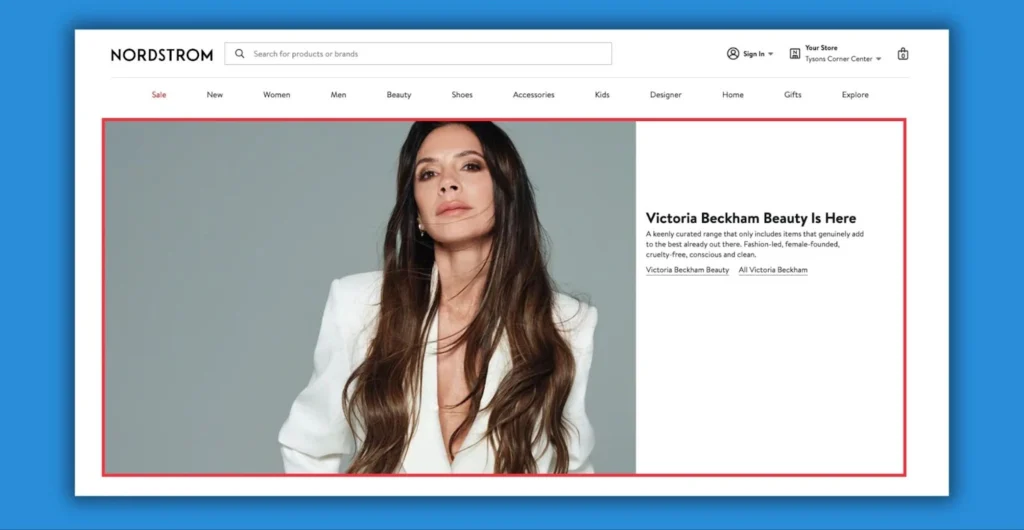
Nordstrom features a curated storefront of Victoria Beckham beauty products on their home page.
Popular ad placements
Retail media ads can appear in various locations across a brand’s onsite and offsite properties. Here are some of the most common placements.
Sponsored search placements
Top-of-search placement maximizes exposure for relevant products and brands, appearing as search ads, display, or video formats. This is the go-to placement, making up 64 percent of all retail media ad spend currently.
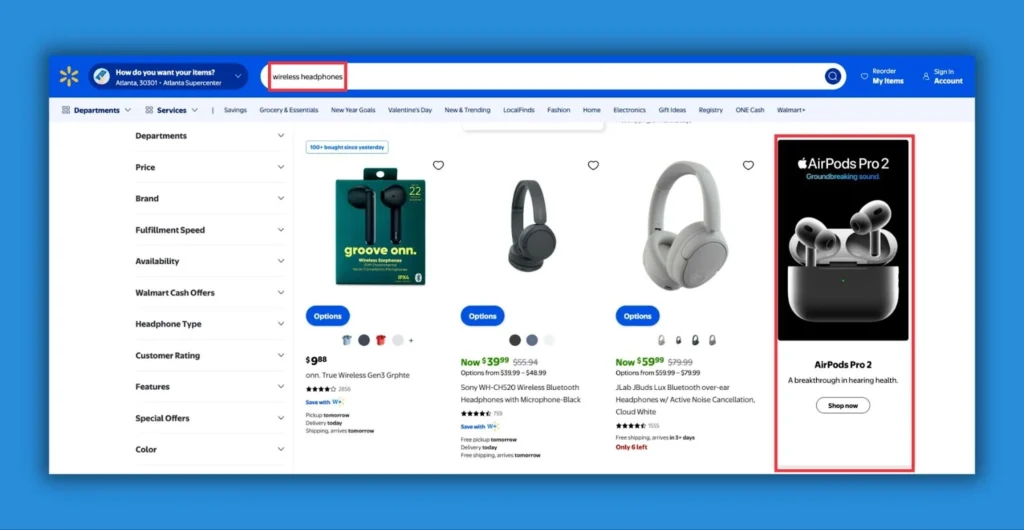
Walmart features a display ad for Apple’s AirPods Pro among its search results for “wireless headphones.”
Category page ads
Some retail media ads appear on product category pages, highlighting products within relevant sections to boost discoverability.
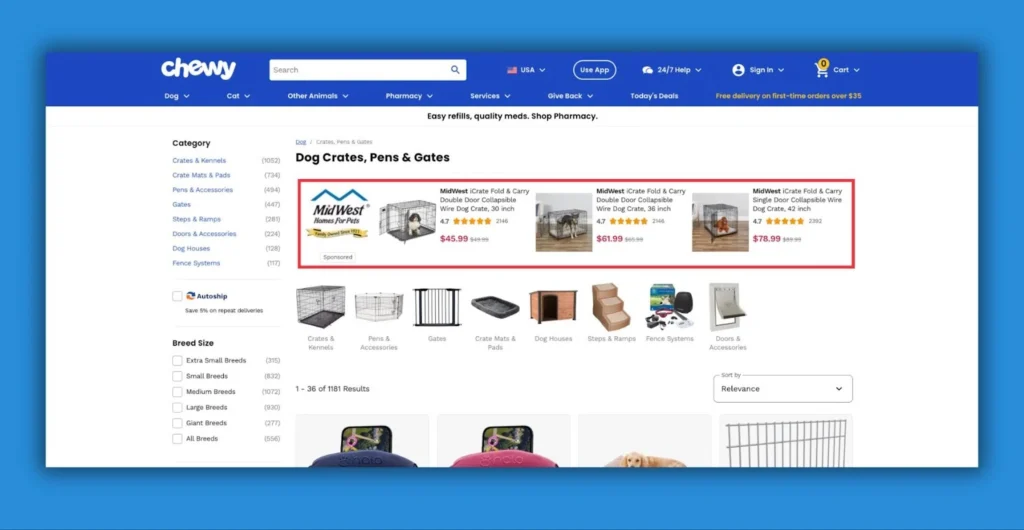
Chewy uses sponsored display ads to surface relevant products on their Product Category pages.
Checkout ads
Checkout ads encourage last-minute purchases as users complete transactions.
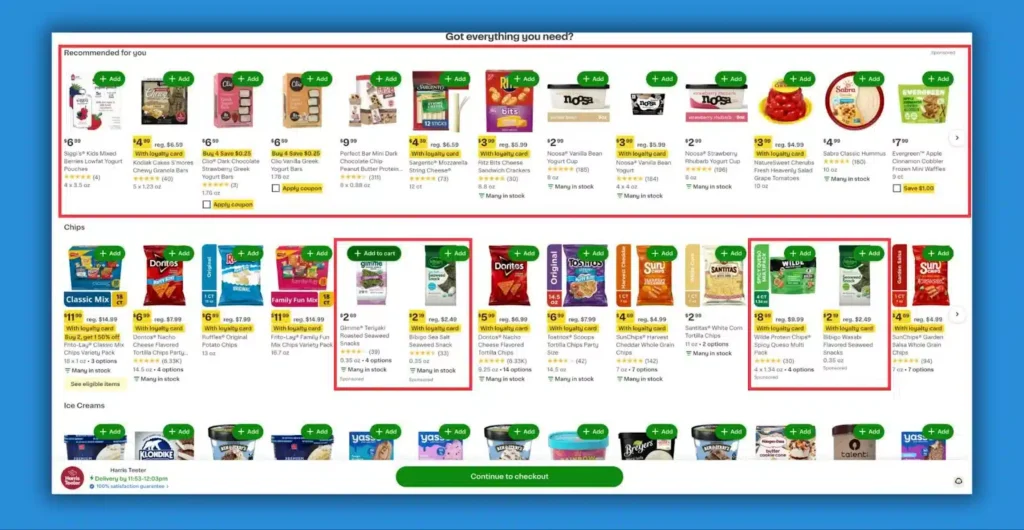
Instacart showcases sponsored products amid other last-minute buys before checkout.
Post-transaction ads
Post-transaction ads are shown to customers after completing a purchase. Typically, they promote complementary products, aiming to encourage repeat purchases and long-term customer loyalty.
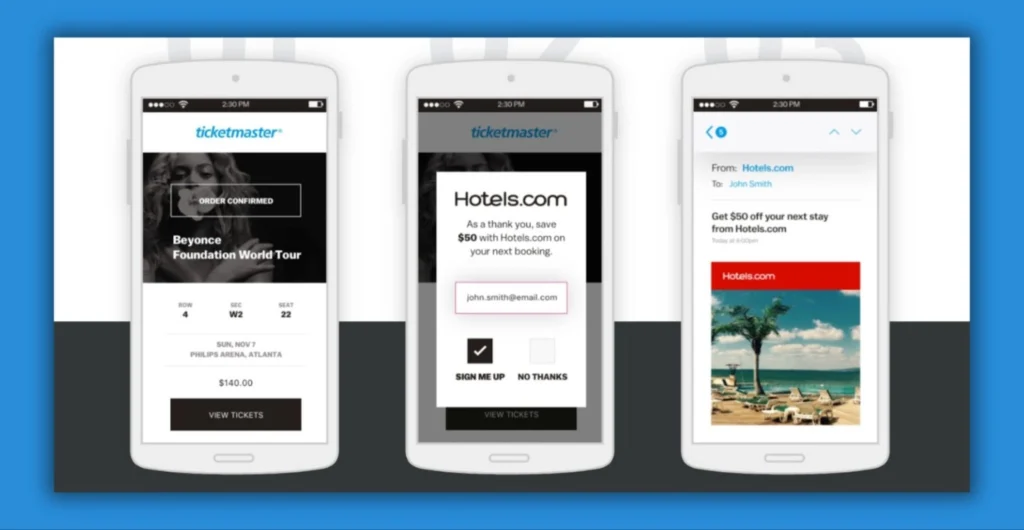
Image source: Github
Retargeting ads
Retargeting ads, also known as offsite ad placements, reach users on external websites. Typically, the ads highlight products or brands the user previously viewed on the retailer’s site.
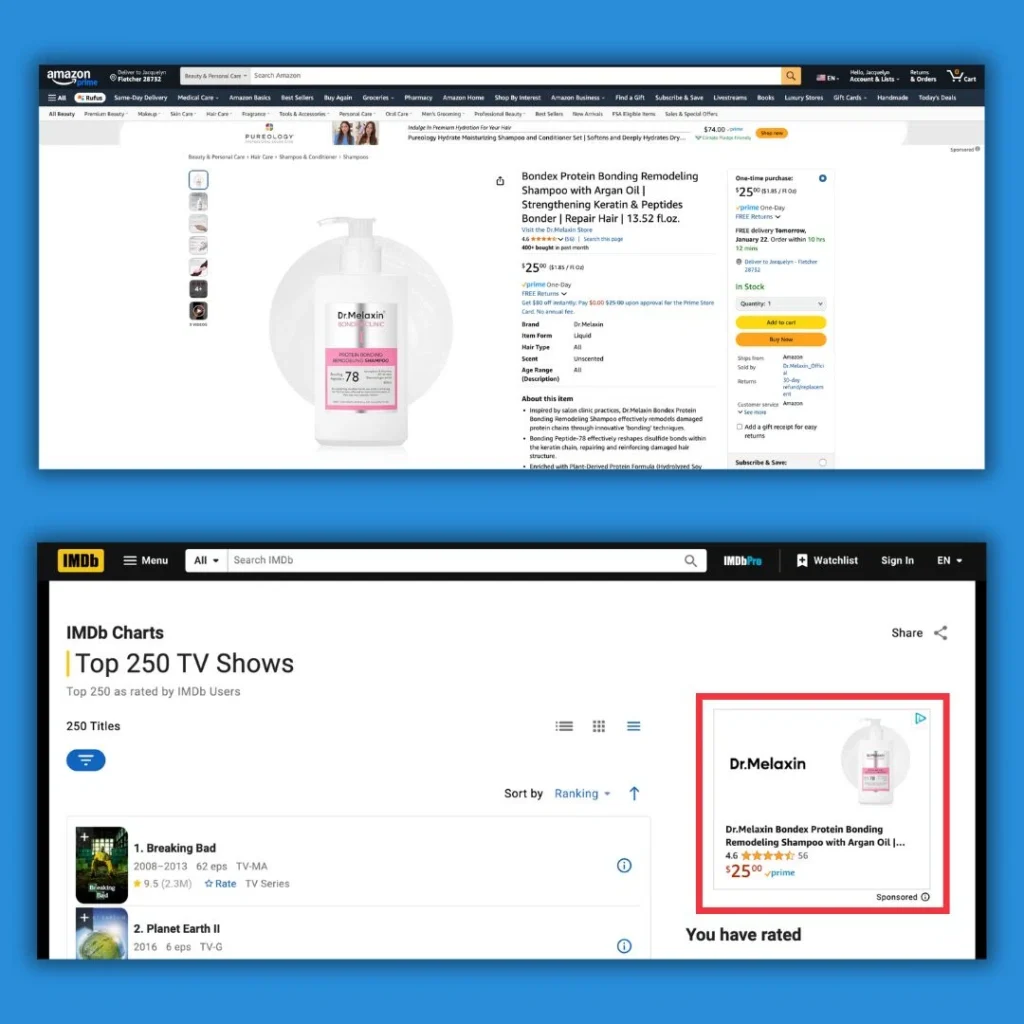
Amazon uses first-party data to show retargeting ads across its affiliate ad network on IMDb to remind consumers of products they’ve considered.
The top retail media networks and what they offer
A retail media network is the actual business unit that a retailer sets up to sell media to advertisers.
While some industry leaders currently dominate the market, there’s a rising trend of brands launching their own retail media networks.
Let’s explore some of the most prominent retail media networks and what they offer brands.
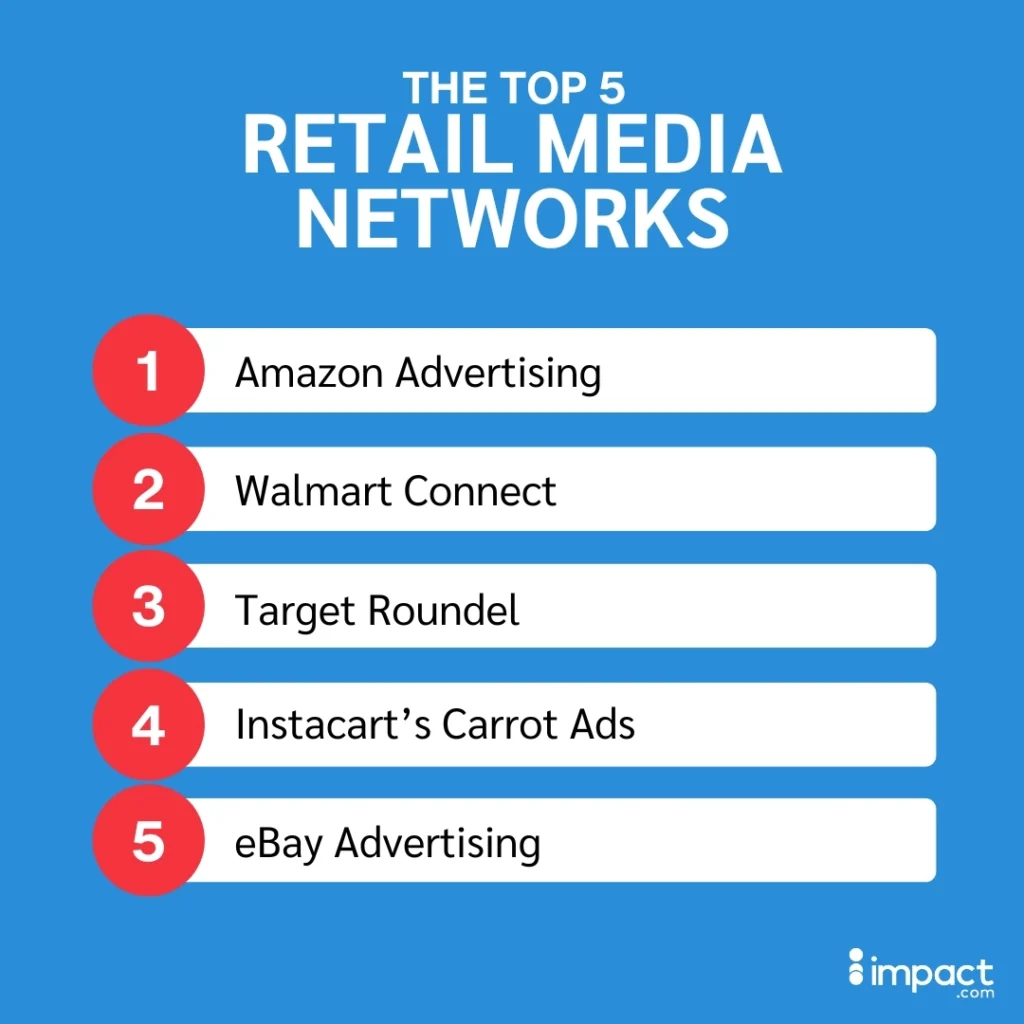
Source: eMarketer
Amazon Advertising
As the world’s largest e-commerce platform, it’s no surprise that Amazon Advertising is the most profitable retail media network. They account for almost 75 percent of retail media spend in the U.S.
Amazon ads are popular with brands due to their high conversion rate and strong consumer trust. Over half of surveyed shoppers say they’re more likely to buy something after seeing an ad on Amazon.
Amazon offers a wide range of ad placement options, including:
- Sponsored product ads
- Sponsored search ads
- Display ads
- Brand shopping experiences, such as digital storefronts and imagery on Amazon’s shoppable feed
- Promotion on Amazon Live
- Amazon device ads
- A variety of retargeting ad options in different formats, ranging from Google search ads to audio ads
- Out-of-home options, such as ads on packages or locker pickup locations
The network provides a variety of formats that can be expertly tailored to your target market.
One key benefit of Amazon Advertising is the ability to reach customers based on their purchase history and search activity on the platform allows brands to deliver highly focused and relevant ads to their audience.
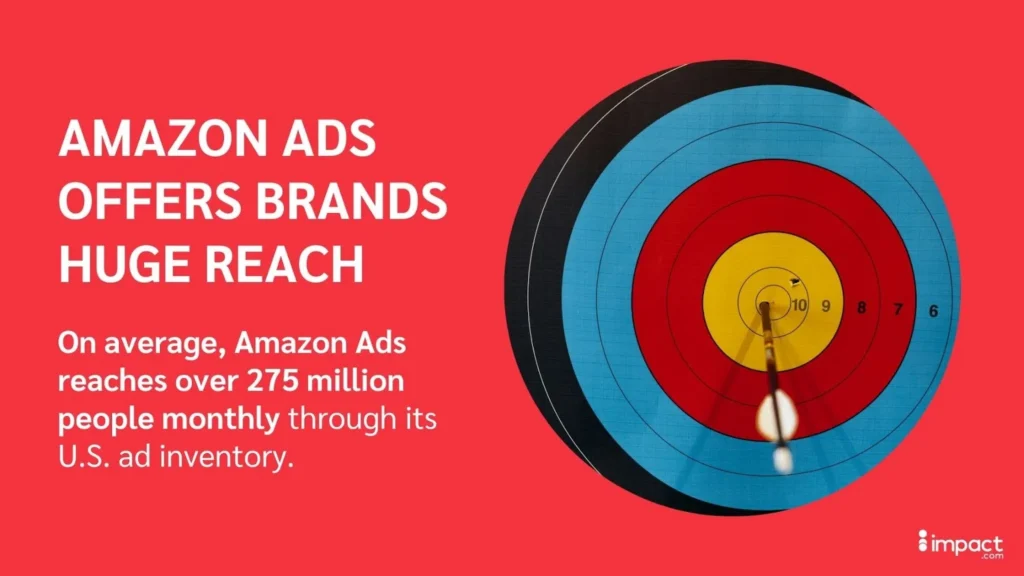
Source: Amazon Advertising
Walmart Connect
Walmart Connect is rapidly growing in popularity. Nearly half (46 percent) of marketers used Walmart Connect in 2024, up from just 24 percent in 2023.
Their key offerings include ad placements such as:
- Sponsored product ads
- Search ads
- Display ads
- Digital storefronts
- Social media ads
- Variety of retargeting options such as CTV, audio streaming, and more
- In-store options, such as digital screens and product demos
One unique benefit of Walmart Connect is its diverse onsite, offsite, and in-person channels. This allows brands to create robust cross-channel campaigns that can guide shoppers from online browsing to in-store purchases.
For example, a brand could use Walmart’s advanced targeting tools to connect with younger audiences via shoppable CTV ads while enhancing product visibility in-store through digital displays.
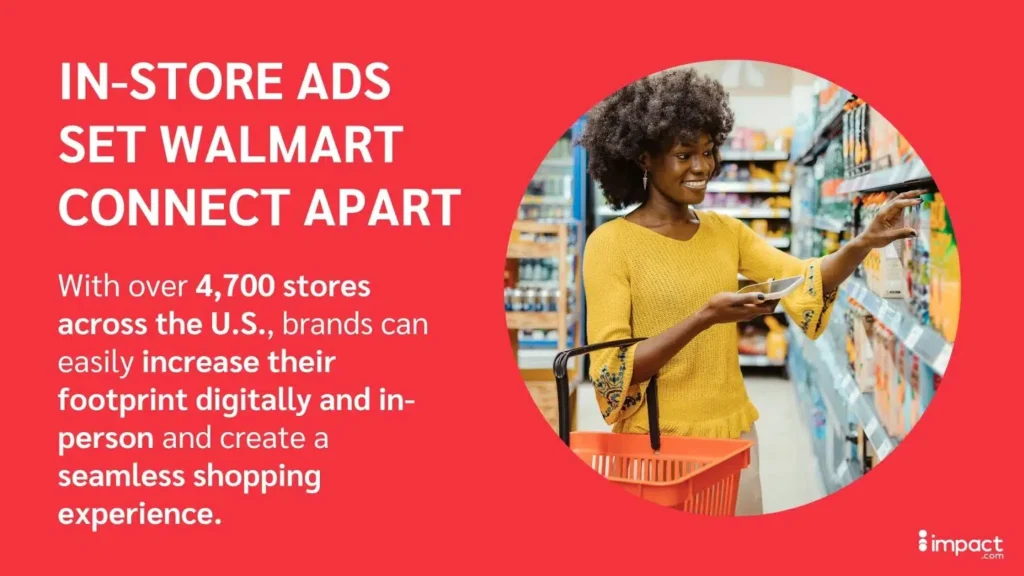
Source: Walmart Connect
Target Roundel
Target Roundel excels as a retail media network, delivering a curated media mix that places ads in the most relevant and impactful moments.
By blending creative ad formats, Target enables campaigns tailored to various goals—from boosting sales to enhancing awareness.
Their key offerings include:
- Sponsored product ads
- Search ads
- Display ads
- Programmatic ads
- CTV ads
- Social media ads
- Co-branded content with influencers
Integration with loyalty programs like Target Circle further boosts its value, as brands can target over 100 million highly engaged shoppers.
Additionally, Target’s social media partnership offerings and influencer campaigns through LTK amplify brand reach and engagement.
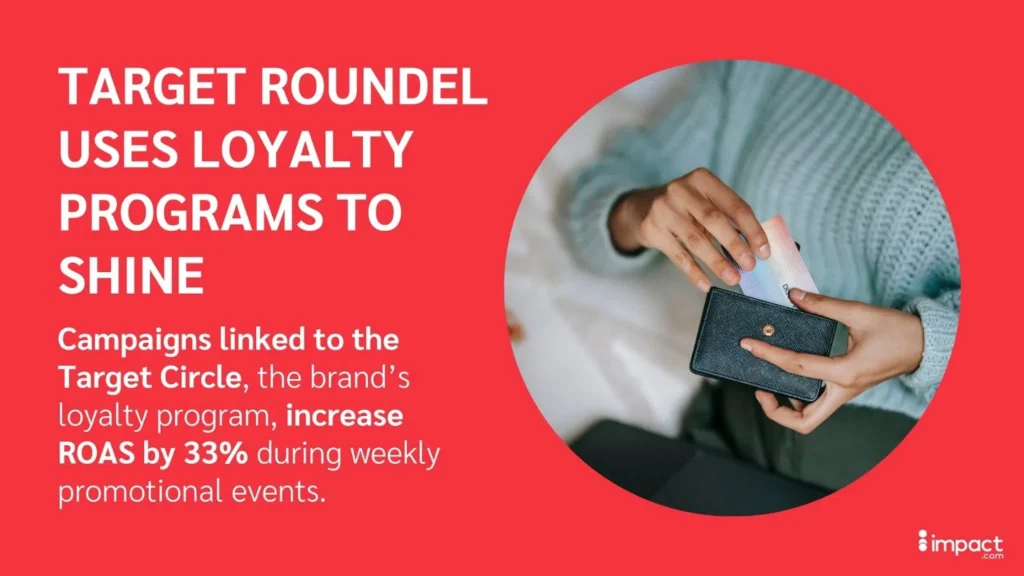
Source: Marketing Brew
Use retail media’s unique strengths to your advantage
Retail media marketing transforms how brands connect with high-intent audiences. It offers unique advantages like first-party data, closed-loop attribution, and personalized ad experiences.
Brand marketers should explore retail media’s potential and experiment with different ad types and placements to optimize reach and engagement. As retail media networks expand their offerings, innovative opportunities will continue to emerge.
If you want to stay ahead, now is the time to integrate retail media into your advertising strategy. By aligning your marketing plan with this channel, you’ll maximize ROI, improve ad performance, and build stronger connections with your audience.
Discover more about how to make the most of your omnichannel marketing strategy:
- From full funnel to full circle: 5 ways marketers can adapt to the new digital marketing funnel (blog)
- What is multi-channel attribution? [Basics and best practices for 2025] (blog)
- Ultimate guide to partnership marketing (blog)
FAQs
Retail media refers to advertising on a retailer’s owned properties, such as websites, apps, or in-store displays. It targets active shoppers close to the point of purchase, raising conversion rates and return on ad spend (ROAS) for brands.
Retail media ads include various ad types shown on the retailer’s platforms (onsite) and across external platforms (offsite). These can come in many forms, including display ads, sponsored product listings, video content, search ads, and retargeting campaigns across external websites.
Retail media focuses on serving different ads on retailer-owned platforms and within their partnered networks. Commerce media encompasses broader advertising channels such as travel, review websites, and third-party apps.
